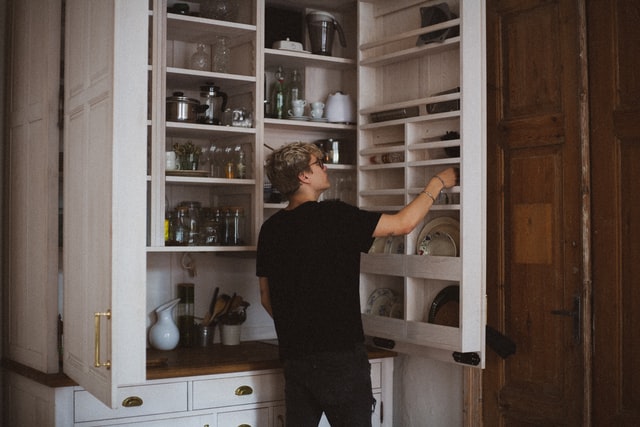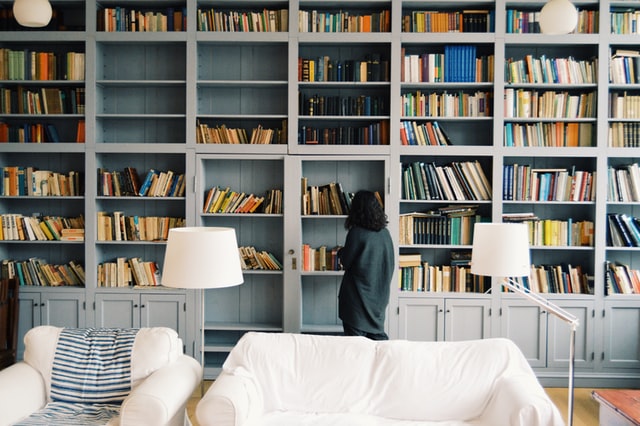It’s been 7 years since the infamous KonMari method entered our lives, where we were encouraged to declutter our homes through a process of sorting our belongings into categories and deciding which things ‘sparked joy’. Since then, decluttering has become the ultimate buzz word in wellness and it is big business. There are now professional declutterers who you can pay to come into your home and sort out your stuff for you.
Decluttering is tiring, it can be emotionally draining, and it can take up a serious amount of time, so it’s no wonder people are happy to pay for this service. However, having strangers rooting through your personal belongings isn’t for everyone and we believe that with a little bit of help everyone is capable of taking on the challenge of decluttering their homes.
A big part of this is about working on your mindset and changing the way you approach clutter, learning to not become too attached to objects that have no sentimental meaning or practical use to you. If you can conquer this, then both your living space and your mind will feel so much better for it. After all a tidy house is a tidy mind and we want to help you get there.
We’ve put together a few simple ways to help you declutter your home for yourself:
If You’re Not Ready To Part With It, Store It
OK so I know this seems a little counterintuitive, but stick with us. If you’re someone who is, shall we say, a bit of a clutterbug, the process of getting rid of some of your worldly possessions isn’t exactly going to be easy. And whilst you need to be strict with yourself, this isn’t something that is going to come naturally to you and certainly won’t be an overnight change. Which is why we think putting certain items into somewhere like Magenta self storage is an essential part of the decluttering process.
Although there is of course a cost involved when using storage facilities, we think this is a small price to pay for the benefits it brings in helping you to declutter. Because one of the crucial elements of decluttering, and certainly one that will motivate you to see the process through to the end, is progress. The feeling that you are getting somewhere with it. Let’s face it when you first take on something like this, it can seem incredibly daunting and overwhelming. And when we feel overwhelmed we are much more likely to run away, defeated and feeling as if we have failed.
In order to feel as though you’re making progress it’s really useful to move some of your items into storage for a while, to help create space in your home and for you to really focus on what needs doing, one box at a time. The simple act of creating space is enough to free up your mind, to help you breathe more easily over what could potentially be a highly anxious exercise.
As for the items in storage? Well, if they end up staying in storage for a couple of months or longer, perhaps it’s time to question whether you have missed any of them, and whether in fact you need any of them back in your life again.
Start Small
The best way to approach decluttering is to focus either on one area or one category of item at a time, rather than tackling a whole room. So for instance, you could say to yourself, “today I am going to sort through the kitchen drawers” and limit yourself to exactly this. This is a totally achievable goal, a task that you can easily complete within a couple of hours tops (depending on the number of drawers!). There’s no better feeling than the feeling you get from ticking off an item on your declutter to do list let me tell you. You are going to feel proper smug and this will fire up your passion and inspire you to continue your decluttering journey.
Another way you could approach it is to set yourself a time limit. Not a long one, maybe say an hour at most, so again keeping it small and achievable. Before you start, write down a few things you would like to get done in this time frame. Here are a few suggestions to get you started:
- Magazines/Newspapers – Flick through magazines taking pictures of any recipes/clothes/products/home inspo etc. that you love. It’s much better to have these on your phone rather than to rip out pages and create a different kind of clutter. Put any old magazines or newspapers in the recycling bin.
- Clothes – Sorting through your entire wardrobe can take forever, so instead focus on a few areas such as your underwear drawer or your jewellery box.
- Bookshelves – Pick just one bookshelf and decide whether you really need all of the books on it. Spend no longer than 5 minutes per book to ensure you aren’t distracted or become too emotionally attached to it. Question how much joy the book brings you, whether you are likely to read it again, whether or not it deserves a space on your shelf. Any that don’t, put to one side ready to take to the charity shop next time you go.
- Food Items – Empty out your pantry and check the expiry dates of those tins and jars lurking at the back. Throw out any that have expired and move any whose dates run out soon to the front of the cupboard to make sure you use them in time. Any that are in date but that you know you won’t use donate to your local food bank.

Take Before, During And After Photos
It’s always a good idea to document your journey, not just for memories sake but also to help aid you in the future. Taking photos before, during and after will help show you what you have achieved. But not only that, it will also remind you how you used to live and will likely evoke negative feelings of how it made you feel to live amongst clutter. This should be enough to keep you on the straight and narrow, helping you to adopt daily habits that allow you to stay on top of things.
Many of us work better with visuals and photos are a great way of documenting where things belong. Take photos of your rooms, but also details such as what your bookshelves look like, inside your drawers and wardrobes, bathroom cabinets, your fridge etc. If in the future you notice that things are starting to look untidy again, check back at your photos and see what’s changed. You can then use them as visual guides to tidy up before things get out of hand – a bit like a declutter manual if you like.
One good habit to adopt that should help prevent an influx of new clutter is to stick to the ‘one in one out’ rule. This means that whenever you buy something new or bring something different into the house, no matter what that object might be, you should get rid of one item you already have. This prevents you having more than you need and stops the overwhelm – both for you and your home.

Consider Professional Help
I know we started this post by saying you can do this decluttering lark on your own, but for some jobs it totally makes sense to call in the professionals and get some help. For example, if you have lots of old photos (you know, actual real life hold in your hand print photos) you understandably won’t want to get rid of them. They contain so many memories and are entirely personal to you, so we’re not asking you to bin them or for someone else to go through them and decide which ones you should and shouldn’t keep. But on the flip side, packs of photos and photo albums take up a lot of room, and for the most part remain hidden away in cupboards or collecting dust on shelves.
Professional declutterers have many strings to their bows and it’s up to you to do a bit of research and find one that can do the jobs you need them to do, such as transferring your print photos into digital files. Make no mistake, this is a lengthy process, and one that would take you way longer than someone who does this for a job and who also wouldn’t be wasting time reminiscing about ‘that time in France’. Once you have your photos stored digitally you can throw away the hard copies, keeping a couple of your favourites to put in frames and have on display in your home. You may find the throwing away process difficult, but remember your photos are safe, in fact safer and more protected than the hard copies, which over time could deteriorate and fade.
Another time consuming task that makes sense to designate to the professionals is sorting through music and films. Nowadays, most of us stream what we watch and listen to, but the older ones among us almost certainly have cupboards filled with CDs, DVDs, Vinyl and even VHS tapes. Most of which we no longer have the devices to play them on and so they sit there unused, but we can’t bear to part with them. Hire someone who can sort it out for you, by either transferring to digital files, or by sourcing streamed or digital copies for you and then

Ask The 3 Important Questions
The most important thing to work on before you physically start the decluttering process, is your mindset. It is essential you learn to shift your mindset to allow it to give you permission to get rid of things. And one thing that can help you with this is by asking yourself the following 3 questions about each item that you might potentially get rid of from your home:
- Why do I own this? Think about where the item came from, the reason you bought it/was given it in the first place. It’s original purpose.
- How does it add value to my life? Now think about whether this item has purpose in your life now. Maybe you no longer have as much use for it as you once did or maybe you no longer like how it looks if your style preferences have changed. Is it useful to you in anyway? Do you love it? Or in KonMari terms does it ‘spark joy’?
- Why should I keep it? And finally, ask yourself why it deserves a place in your home. Do you really need it? Would you miss it if it was gone?
There will naturally be some items that tug at the heart strings, that you can’t quite decide on whether to keep or not, and it is totally fine to have a ‘maybe’ pile. These maybe items are perhaps the ones you should consider putting into storage so that you can give yourself some time and to then revisit them and ask yourself the same three questions again.

The decluttering process can be emotionally fraught, particularly if there are other issues at play. In the process you may discover things about yourself that you’ve never realised before and so in a sense it becomes a form of personal therapy. You and only you can decide which things to part with, but hopefully the tips above will help guide you on your way to making your home clutter free.
*collaborative post


























